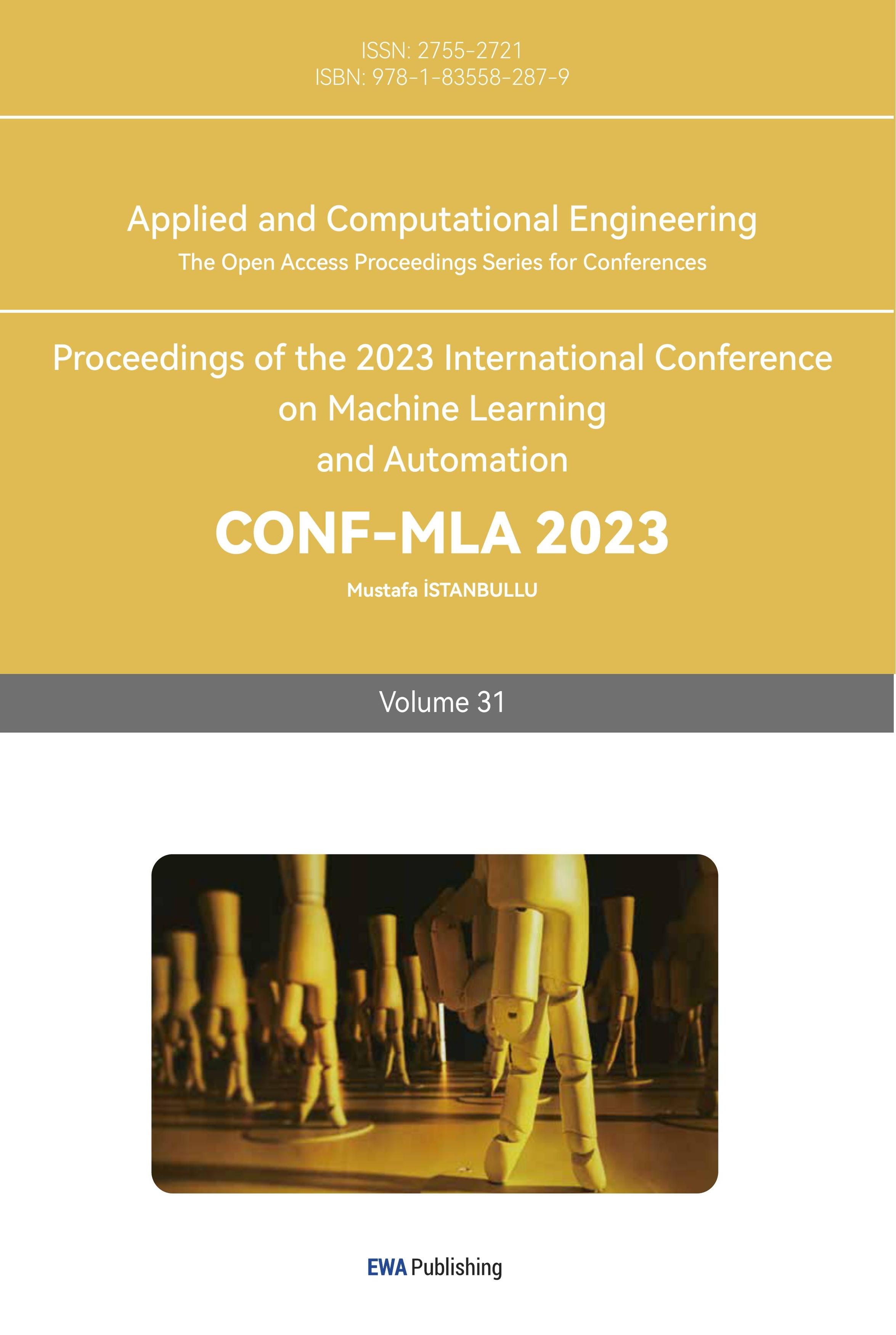References
[1]. Aloqail, M., Bouachir, O., & Karray, F. (2023). Digital twin for healthcare immersive services: fundamentals, architectures, and open issues. In Digital Twin for Healthcare: Design, challenges and solutions. essay, Academic Press, an imprint of Elsevier.
[2]. University of Silicon Valley. (2021b, June 22). WHAT IS THE GOAL OF VIRTUAL REALITY? [web log]. Retrieved July 17, 2023, from https://usv.edu/blog/what-is-the-goal-of-virtual-reality/.
[3]. TechTarget. (2017, May 6). Head Tracking. WhatIs.com. https://www.techtarget.com/whatis/definition/head-tracking#:~:text=Head%20tracking%20is%20often%20used,methods%20used%20for%20head%20tracking.
[4]. Truly, A. (2023, March 8). What is screen door effect in VR?. digitaltrends.com. https://www.digitaltrends.com/computing/what-is-screen-door-effect-in-vr/
[5]. Hynes, N. J., Cufflin, M. P., Hampson, K. M., & Mallen, E. A. (2022). The effect of image resolution of display types on accommodative microfluctuations. Ophthalmic & physiological optics : the journal of the British College of Ophthalmic Opticians (Optometrists), 42(3), 514–525. https://doi.org/10.1111/opo.12949
[6]. Webster, M. (2007, November 8). Sitting too close to the Computer Screen Can Make You Go Blind. scientificamerican.com. https://www.scientificamerican.com/article/is-sitting-too-close-to-screen-making-you-blind/
[7]. Wang, J., Shi, R., Zheng, W., Xie, W., Kao, D., & Liang, H. N. (2023). Effect of Frame Rate on User Experience, Performance, and Simulator Sickness in Virtual Reality. IEEE transactions on visualization and computer graphics, PP, 10.1109/TVCG.2023.3247057. Advance online publication. https://doi.org/10.1109/TVCG.2023.3247057
[8]. Zimmerman, T. (1982). Optical flex sensor (U.S Patent No. 4542291A). U.S. Patent and Trademark Office. https://patents.google.com/patent/US4542291A/en#patentCitations
[9]. What is an inertial measurement unit?. vectornav.com. (n.d.). https://www.vectornav.com/resources/inertial-navigation-articles/what-is-an-inertial-measurement-unit-imu?gclid=Cj0KCQjwzdOlBhCNARIsAPMwjbzIB1mrPMnihJANDSp9KlCnDnf9jM1GNn1cnUvSurEDz3a9m8PBvwQaAi5QEALw_wcB
[10]. VR Components. washington.edu. (n.d.). https://www.hitl.washington.edu/projects/learning_center/pf/whatvr1a.htm
[11]. Culling explained. Documentation. (n.d.). https://docs.cryengine.com/display/SDKDOC4/Culling+Explained
[12]. Kleiner, M., Dalenbäck, B.-I., & Svensson, P. (1993). Auralization--An Overview. JOURNAL OF THE AUDIO ENGINEERING SOCIETY, 41(11), 861–875. https://doi.org/http://www.mattmontag.com/auralization/media/Auralization%20-%20An%20Overview.pdf
[13]. Slater, M., & Wilbur, S. (1997). A Framework for Immersive Virtual Environments (FIVE): Speculations on the Role of Presence in Virtual Environments. Presence: Teleoperators & Virtual Environments, 6, 603-616.
Cite this article
Lai,Z. (2024). Diving into the virtual realm: Exploring the mechanics of virtual reality. Applied and Computational Engineering,31,268-273.
Data availability
The datasets used and/or analyzed during the current study will be available from the authors upon reasonable request.
Disclaimer/Publisher's Note
The statements, opinions and data contained in all publications are solely those of the individual author(s) and contributor(s) and not of EWA Publishing and/or the editor(s). EWA Publishing and/or the editor(s) disclaim responsibility for any injury to people or property resulting from any ideas, methods, instructions or products referred to in the content.
About volume
Volume title: Proceedings of the 2023 International Conference on Machine Learning and Automation
© 2024 by the author(s). Licensee EWA Publishing, Oxford, UK. This article is an open access article distributed under the terms and
conditions of the Creative Commons Attribution (CC BY) license. Authors who
publish this series agree to the following terms:
1. Authors retain copyright and grant the series right of first publication with the work simultaneously licensed under a Creative Commons
Attribution License that allows others to share the work with an acknowledgment of the work's authorship and initial publication in this
series.
2. Authors are able to enter into separate, additional contractual arrangements for the non-exclusive distribution of the series's published
version of the work (e.g., post it to an institutional repository or publish it in a book), with an acknowledgment of its initial
publication in this series.
3. Authors are permitted and encouraged to post their work online (e.g., in institutional repositories or on their website) prior to and
during the submission process, as it can lead to productive exchanges, as well as earlier and greater citation of published work (See
Open access policy for details).
References
[1]. Aloqail, M., Bouachir, O., & Karray, F. (2023). Digital twin for healthcare immersive services: fundamentals, architectures, and open issues. In Digital Twin for Healthcare: Design, challenges and solutions. essay, Academic Press, an imprint of Elsevier.
[2]. University of Silicon Valley. (2021b, June 22). WHAT IS THE GOAL OF VIRTUAL REALITY? [web log]. Retrieved July 17, 2023, from https://usv.edu/blog/what-is-the-goal-of-virtual-reality/.
[3]. TechTarget. (2017, May 6). Head Tracking. WhatIs.com. https://www.techtarget.com/whatis/definition/head-tracking#:~:text=Head%20tracking%20is%20often%20used,methods%20used%20for%20head%20tracking.
[4]. Truly, A. (2023, March 8). What is screen door effect in VR?. digitaltrends.com. https://www.digitaltrends.com/computing/what-is-screen-door-effect-in-vr/
[5]. Hynes, N. J., Cufflin, M. P., Hampson, K. M., & Mallen, E. A. (2022). The effect of image resolution of display types on accommodative microfluctuations. Ophthalmic & physiological optics : the journal of the British College of Ophthalmic Opticians (Optometrists), 42(3), 514–525. https://doi.org/10.1111/opo.12949
[6]. Webster, M. (2007, November 8). Sitting too close to the Computer Screen Can Make You Go Blind. scientificamerican.com. https://www.scientificamerican.com/article/is-sitting-too-close-to-screen-making-you-blind/
[7]. Wang, J., Shi, R., Zheng, W., Xie, W., Kao, D., & Liang, H. N. (2023). Effect of Frame Rate on User Experience, Performance, and Simulator Sickness in Virtual Reality. IEEE transactions on visualization and computer graphics, PP, 10.1109/TVCG.2023.3247057. Advance online publication. https://doi.org/10.1109/TVCG.2023.3247057
[8]. Zimmerman, T. (1982). Optical flex sensor (U.S Patent No. 4542291A). U.S. Patent and Trademark Office. https://patents.google.com/patent/US4542291A/en#patentCitations
[9]. What is an inertial measurement unit?. vectornav.com. (n.d.). https://www.vectornav.com/resources/inertial-navigation-articles/what-is-an-inertial-measurement-unit-imu?gclid=Cj0KCQjwzdOlBhCNARIsAPMwjbzIB1mrPMnihJANDSp9KlCnDnf9jM1GNn1cnUvSurEDz3a9m8PBvwQaAi5QEALw_wcB
[10]. VR Components. washington.edu. (n.d.). https://www.hitl.washington.edu/projects/learning_center/pf/whatvr1a.htm
[11]. Culling explained. Documentation. (n.d.). https://docs.cryengine.com/display/SDKDOC4/Culling+Explained
[12]. Kleiner, M., Dalenbäck, B.-I., & Svensson, P. (1993). Auralization--An Overview. JOURNAL OF THE AUDIO ENGINEERING SOCIETY, 41(11), 861–875. https://doi.org/http://www.mattmontag.com/auralization/media/Auralization%20-%20An%20Overview.pdf
[13]. Slater, M., & Wilbur, S. (1997). A Framework for Immersive Virtual Environments (FIVE): Speculations on the Role of Presence in Virtual Environments. Presence: Teleoperators & Virtual Environments, 6, 603-616.









